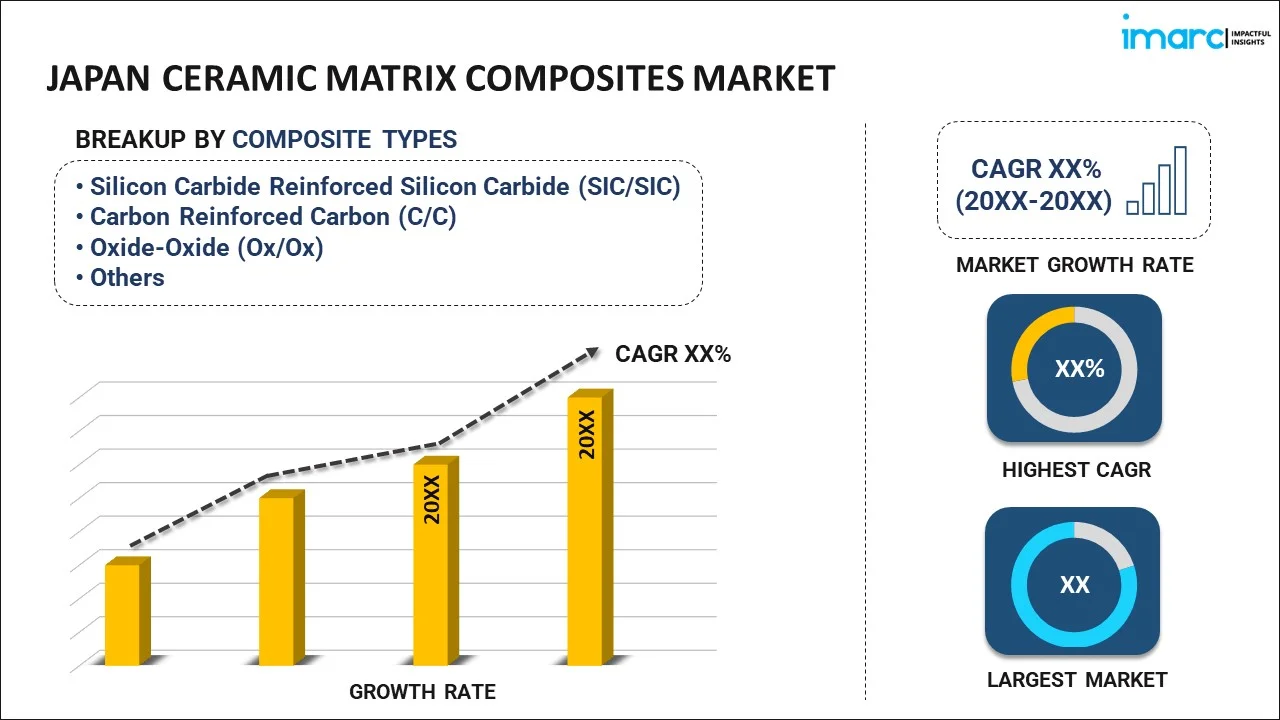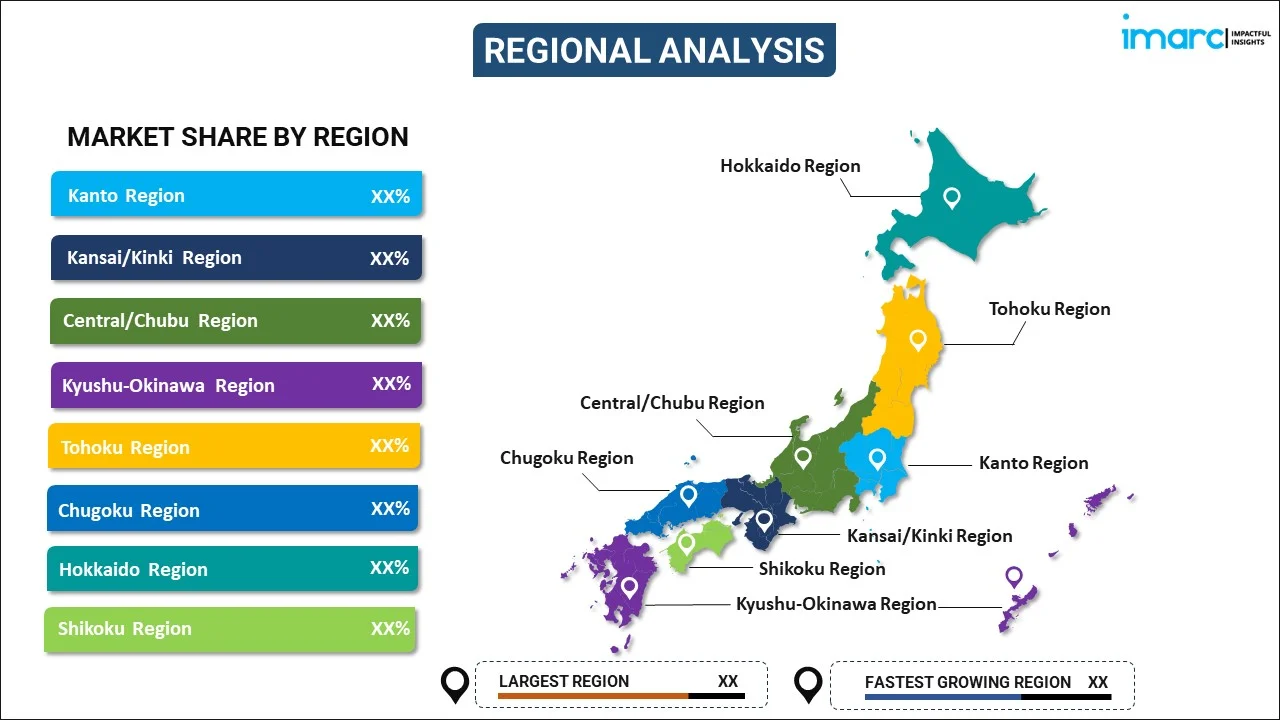
Japan Ceramic Matrix Composites Market Report by Composite Type (Silicon Carbide Reinforced Silicon Carbide (SIC/SIC), Carbon Reinforced Carbon (C/C), Oxide-Oxide (Ox/Ox), and Others), Fiber Type (Short Fiber, Continuous Fiber), Fiber Material (Alumina Fiber, Refractory Ceramic Fiber (RCF), SiC Fiber, and Others), Application (Aerospace and Defense, Automotive, Energy and Power, Electricals and Electronics, and Others), and Region 2026-2034
Market Overview:
Japan ceramic matrix composites market size reached USD 532.9 Million in 2025. Looking forward, IMARC Group expects the market to reach USD 1,121.0 Million by 2034, exhibiting a growth rate (CAGR) of 8.61% during 2026-2034. The expanding aerospace industry and the escalating application of ceramic matrix composites in aircraft engines, exhaust nozzles, and other high-temperature components to reduce weight and improve fuel efficiency, is driving the market.
|
Report Attribute
|
Key Statistics
|
|---|---|
|
Base Year
|
2025
|
|
Forecast Years
|
2026-2034
|
|
Historical Years
|
2020-2025
|
|
Market Size in 2025
|
USD 532.9 Million |
|
Market Forecast in 2034
|
USD 1,121.0 Million |
| Market Growth Rate 2026-2034 | 8.61% |
Ceramic matrix composites (CMCs) are advanced materials that combine ceramic fibers or particles with a ceramic matrix to create a high-performance composite material. These composites offer exceptional strength, toughness, and resistance to extreme temperatures, making them ideal for demanding applications in aerospace, automotive, and energy industries. CMCs are designed to overcome the limitations of traditional ceramics, which are brittle and prone to fracture. By incorporating reinforcing fibers or particles, CMCs can maintain their structural integrity under stress and at elevated temperatures, often exceeding 2000°C (3632°F). This exceptional thermal stability makes them valuable for applications such as aircraft engine components and rocket nozzles. CMCs also possess a low density, which contributes to their use in lightweight structures, reducing fuel consumption in aerospace applications. Additionally, their resistance to corrosion and wear makes them suitable for harsh environments. While CMCs are still evolving, they hold promise for revolutionizing industries that require high-performance materials capable of withstanding extreme conditions.
Japan Ceramic Matrix Composites Market Trends:
The ceramic matrix composites market in Japan has been experiencing remarkable growth in recent years, primarily due to several key drivers. Firstly, their exceptional high-temperature resistance and lightweight properties have made them a preferred choice in aerospace and aviation applications. Additionally, stringent environmental regulations have propelled the demand for CMCs as they offer reduced emissions and fuel consumption, aligning with regional sustainability goals. Furthermore, advancements in manufacturing technologies have lowered production costs, making CMCs more accessible to various industries, including automotive and energy. Moreover, their enhanced durability and corrosion resistance have expanded their utility in harsh industrial environments, driving adoption across sectors. Innovation in R&D activities has resulted in novel CMC formulations, broadening their scope in emerging markets such as electronics and healthcare. Simultaneously, the increasing focus on improving energy efficiency and performance in various sectors that have led to a surge in demand for CMC-based solutions is expected to drive the CMCs market in Japan during the forecast period.
Japan Ceramic Matrix Composites Market Segmentation:
IMARC Group provides an analysis of the key trends in each segment of the market, along with forecasts at the country level for 2026-2034. Our report has categorized the market based on composite type, fiber type, fiber material, and application.
Composite Type Insights:

- Silicon Carbide Reinforced Silicon Carbide (SIC/SIC)
- Carbon Reinforced Carbon (C/C)
- Oxide-Oxide (Ox/Ox)
- Others
The report has provided a detailed breakup and analysis of the market based on the composite type. This includes silicon carbide reinforced silicon carbide (SIC/SIC), carbon reinforced carbon (C/C), oxide-oxide (Ox/Ox), and others.
Fiber Type Insights:
- Short Fiber
- Continuous Fiber
A detailed breakup and analysis of the market based on the fiber type have also been provided in the report. This includes short fiber and continuous fiber.
Fiber Material Insights:
- Alumina Fiber
- Refractory Ceramic Fiber (RCF)
- SiC Fiber
- Others
The report has provided a detailed breakup and analysis of the market based on the fiber material. This includes alumina fiber, refractory ceramic fiber (RCF), SiC fiber, and others.
Application Insights:
- Aerospace and Defense
- Automotive
- Energy and Power
- Electricals and Electronics
- Others
A detailed breakup and analysis of the market based on the application have also been provided in the report. This includes aerospace and defense, automotive, energy and power, electricals and electronics, and others.
Regional Insights:

- Kanto Region
- Kansai/Kinki Region
- Central/ Chubu Region
- Kyushu-Okinawa Region
- Tohoku Region
- Chugoku Region
- Hokkaido Region
- Shikoku Region
The report has also provided a comprehensive analysis of all the major regional markets, which include Kanto Region, Kansai/Kinki Region, Central/ Chubu Region, Kyushu-Okinawa Region, Tohoku Region, Chugoku Region, Hokkaido Region, and Shikoku Region.
Competitive Landscape:
The market research report has also provided a comprehensive analysis of the competitive landscape. Competitive analysis such as market structure, key player positioning, top winning strategies, competitive dashboard, and company evaluation quadrant has been covered in the report. Also, detailed profiles of all major companies have been provided.
Japan Ceramic Matrix Composites Market Report Coverage:
| Report Features | Details |
|---|---|
| Base Year of the Analysis | 2025 |
| Historical Period | 2020-2025 |
| Forecast Period | 2026-2034 |
| Units | Million USD |
| Scope of the Report | Exploration of Historical Trends and Market Outlook, Industry Catalysts and Challenges, Segment-Wise Historical and Future Market Assessment:
|
| Composite Types Covered | Silicon Carbide Reinforced Silicon Carbide (SIC/SIC), Carbon Reinforced Carbon (C/C), Oxide-Oxide (Ox/Ox), Others |
| Fiber Types Covered | Short Fiber, Continuous Fiber |
| Fiber Materials Covered | Alumina Fiber, Refractory Ceramic Fiber (RCF), SiC Fiber, Others |
| Applications Covered | Aerospace and Defense, Automotive, Energy and Power, Electricals and Electronics, Others |
| Regions Covered | Kanto Region, Kansai/Kinki Region, Central/ Chubu Region, Kyushu-Okinawa Region, Tohoku Region, Chugoku Region, Hokkaido Region, Shikoku Region |
| Customization Scope | 10% Free Customization |
| Post-Sale Analyst Support | 10-12 Weeks |
| Delivery Format | PDF and Excel through Email (We can also provide the editable version of the report in PPT/Word format on special request) |
Key Questions Answered in This Report:
- How has the Japan ceramic matrix composites market performed so far and how will it perform in the coming years?
- What has been the impact of COVID-19 on the Japan ceramic matrix composites market?
- What is the breakup of the Japan ceramic matrix composites market on the basis of composite type?
- What is the breakup of the Japan ceramic matrix composites market on the basis of fiber type?
- What is the breakup of the Japan ceramic matrix composites market on the basis of fiber material?
- What is the breakup of the Japan ceramic matrix composites market on the basis of application?
- What are the various stages in the value chain of the Japan ceramic matrix composites market?
- What are the key driving factors and challenges in the Japan ceramic matrix composites?
- What is the structure of the Japan ceramic matrix composites market and who are the key players?
- What is the degree of competition in the Japan ceramic matrix composites market?
Key Benefits for Stakeholders:
- IMARC’s industry report offers a comprehensive quantitative analysis of various market segments, historical and current market trends, market forecasts, and dynamics of the Japan ceramic matrix composites market from 2020-2034.
- The research report provides the latest information on the market drivers, challenges, and opportunities in the Japan ceramic matrix composites market.
- Porter's five forces analysis assist stakeholders in assessing the impact of new entrants, competitive rivalry, supplier power, buyer power, and the threat of substitution. It helps stakeholders to analyze the level of competition within the Japan ceramic matrix composites industry and its attractiveness.
- Competitive landscape allows stakeholders to understand their competitive environment and provides an insight into the current positions of key players in the market.
Need more help?
- Speak to our experienced analysts for insights on the current market scenarios.
- Include additional segments and countries to customize the report as per your requirement.
- Gain an unparalleled competitive advantage in your domain by understanding how to utilize the report and positively impacting your operations and revenue.
- For further assistance, please connect with our analysts.
 Request Customization
Request Customization
 Speak to an Analyst
Speak to an Analyst
 Request Brochure
Request Brochure
 Inquire Before Buying
Inquire Before Buying




.webp)




.webp)












